Business Functional Areas Report: Skills and Requirements
VerifiedAdded on 2022/12/26
|9
|1939
|56
Report
AI Summary
This report delves into the functional areas of a business, providing a comprehensive overview of key departments such as marketing, human resources, customer service, finance, research and development, and sales. It defines what constitutes a business and its functional areas, then outlines the specific roles and responsibilities within each department. The report emphasizes the importance of specialized skills for employees in each function, including communication, analytical, and problem-solving abilities. It examines the skills needed by employees in marketing, human resource management, customer service, finance, research and development, and sales, highlighting the need for both hard and soft skills. The report is structured to guide a new business owner, John, in understanding the critical aspects of running a company and is based on secondary research, providing insights into the practical requirements of managing a business effectively. The report also includes an introduction, conclusion, and references. The report is a comprehensive guide to the functional areas of business and the skills required for success in each.
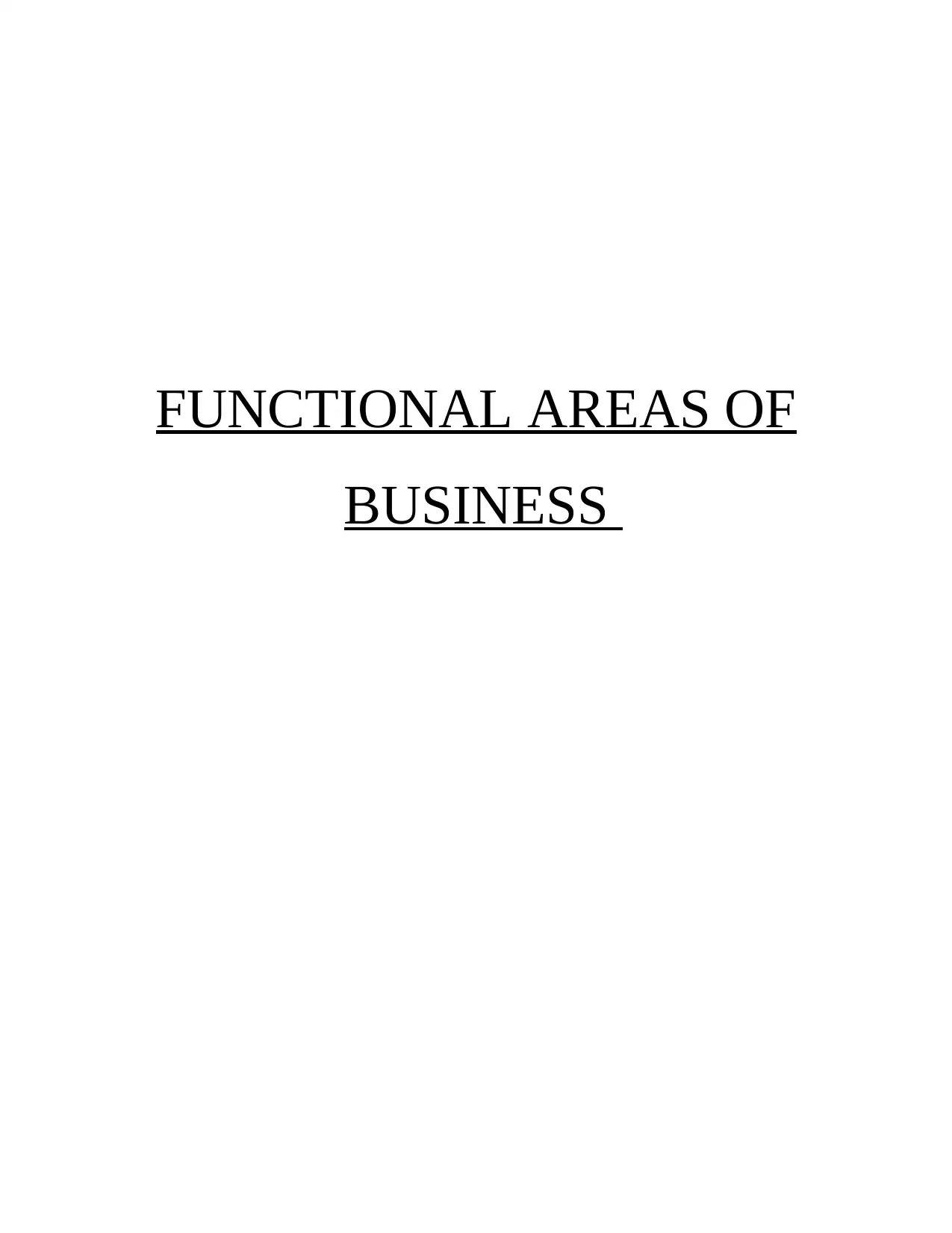
FUNCTIONAL AREAS OF
BUSINESS
BUSINESS
Paraphrase This Document
Need a fresh take? Get an instant paraphrase of this document with our AI Paraphraser
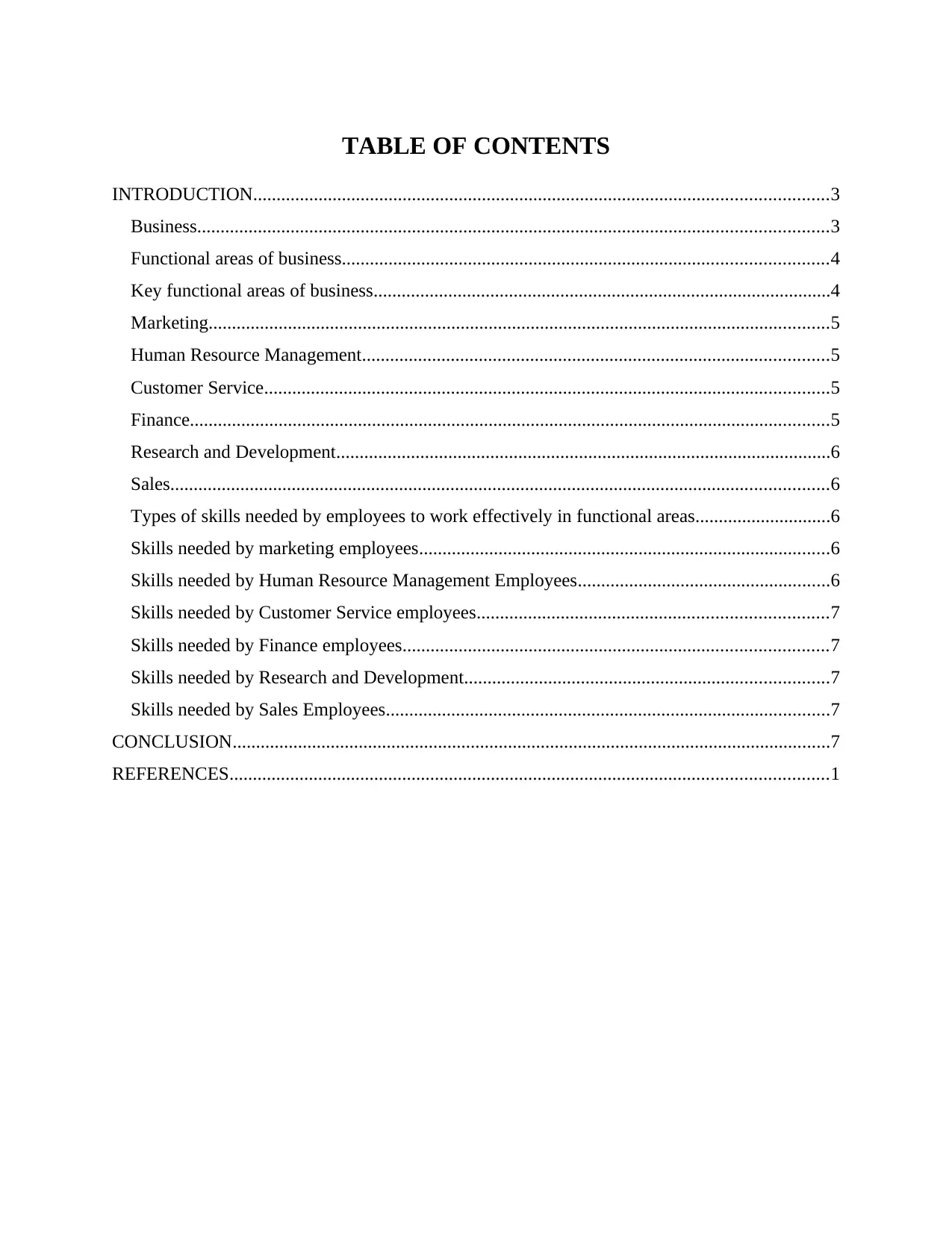
TABLE OF CONTENTS
INTRODUCTION...........................................................................................................................3
Business.......................................................................................................................................3
Functional areas of business........................................................................................................4
Key functional areas of business..................................................................................................4
Marketing.....................................................................................................................................5
Human Resource Management....................................................................................................5
Customer Service.........................................................................................................................5
Finance.........................................................................................................................................5
Research and Development..........................................................................................................6
Sales.............................................................................................................................................6
Types of skills needed by employees to work effectively in functional areas.............................6
Skills needed by marketing employees........................................................................................6
Skills needed by Human Resource Management Employees......................................................6
Skills needed by Customer Service employees...........................................................................7
Skills needed by Finance employees...........................................................................................7
Skills needed by Research and Development..............................................................................7
Skills needed by Sales Employees...............................................................................................7
CONCLUSION................................................................................................................................7
REFERENCES................................................................................................................................1
INTRODUCTION...........................................................................................................................3
Business.......................................................................................................................................3
Functional areas of business........................................................................................................4
Key functional areas of business..................................................................................................4
Marketing.....................................................................................................................................5
Human Resource Management....................................................................................................5
Customer Service.........................................................................................................................5
Finance.........................................................................................................................................5
Research and Development..........................................................................................................6
Sales.............................................................................................................................................6
Types of skills needed by employees to work effectively in functional areas.............................6
Skills needed by marketing employees........................................................................................6
Skills needed by Human Resource Management Employees......................................................6
Skills needed by Customer Service employees...........................................................................7
Skills needed by Finance employees...........................................................................................7
Skills needed by Research and Development..............................................................................7
Skills needed by Sales Employees...............................................................................................7
CONCLUSION................................................................................................................................7
REFERENCES................................................................................................................................1
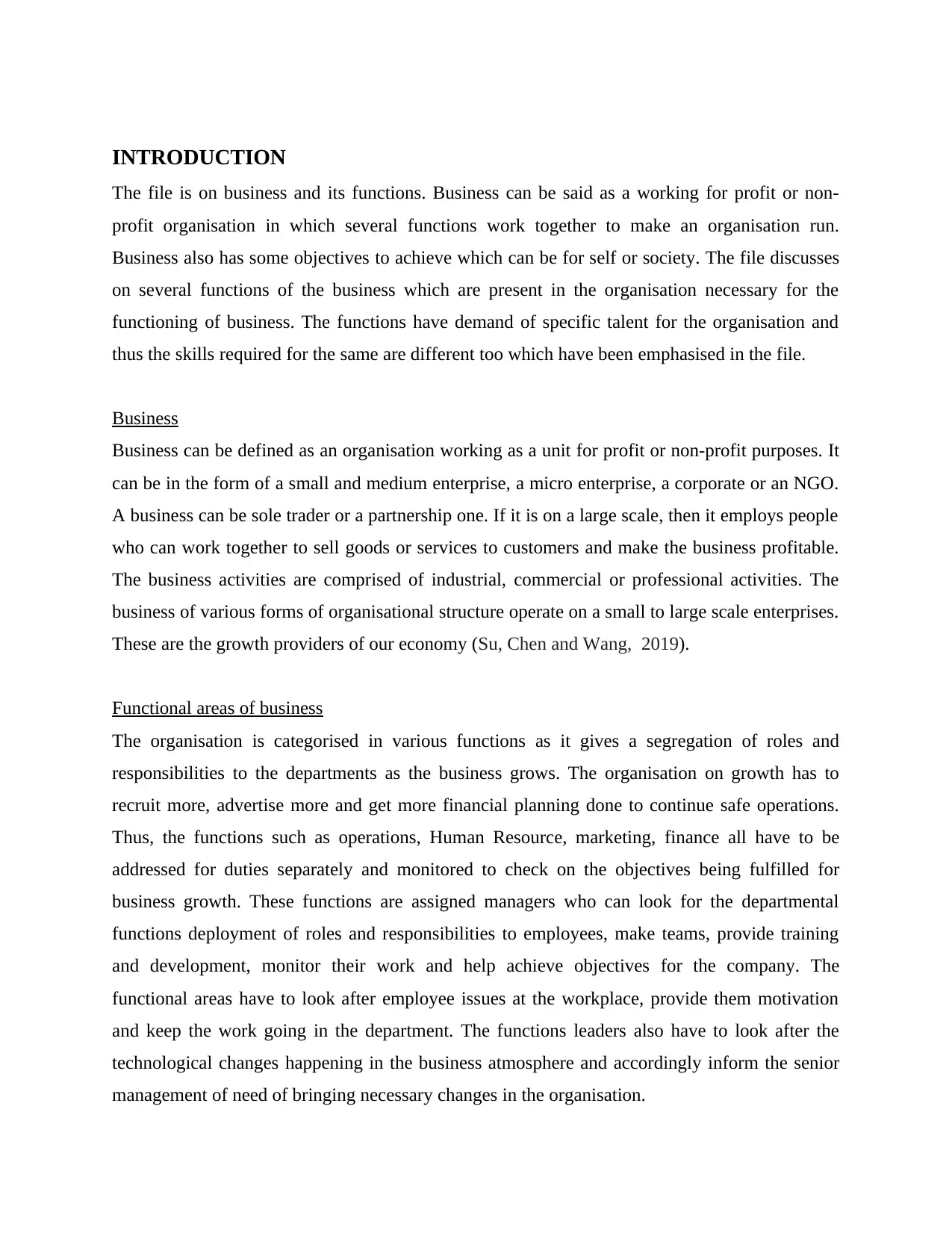
INTRODUCTION
The file is on business and its functions. Business can be said as a working for profit or non-
profit organisation in which several functions work together to make an organisation run.
Business also has some objectives to achieve which can be for self or society. The file discusses
on several functions of the business which are present in the organisation necessary for the
functioning of business. The functions have demand of specific talent for the organisation and
thus the skills required for the same are different too which have been emphasised in the file.
Business
Business can be defined as an organisation working as a unit for profit or non-profit purposes. It
can be in the form of a small and medium enterprise, a micro enterprise, a corporate or an NGO.
A business can be sole trader or a partnership one. If it is on a large scale, then it employs people
who can work together to sell goods or services to customers and make the business profitable.
The business activities are comprised of industrial, commercial or professional activities. The
business of various forms of organisational structure operate on a small to large scale enterprises.
These are the growth providers of our economy (Su, Chen and Wang, 2019).
Functional areas of business
The organisation is categorised in various functions as it gives a segregation of roles and
responsibilities to the departments as the business grows. The organisation on growth has to
recruit more, advertise more and get more financial planning done to continue safe operations.
Thus, the functions such as operations, Human Resource, marketing, finance all have to be
addressed for duties separately and monitored to check on the objectives being fulfilled for
business growth. These functions are assigned managers who can look for the departmental
functions deployment of roles and responsibilities to employees, make teams, provide training
and development, monitor their work and help achieve objectives for the company. The
functional areas have to look after employee issues at the workplace, provide them motivation
and keep the work going in the department. The functions leaders also have to look after the
technological changes happening in the business atmosphere and accordingly inform the senior
management of need of bringing necessary changes in the organisation.
The file is on business and its functions. Business can be said as a working for profit or non-
profit organisation in which several functions work together to make an organisation run.
Business also has some objectives to achieve which can be for self or society. The file discusses
on several functions of the business which are present in the organisation necessary for the
functioning of business. The functions have demand of specific talent for the organisation and
thus the skills required for the same are different too which have been emphasised in the file.
Business
Business can be defined as an organisation working as a unit for profit or non-profit purposes. It
can be in the form of a small and medium enterprise, a micro enterprise, a corporate or an NGO.
A business can be sole trader or a partnership one. If it is on a large scale, then it employs people
who can work together to sell goods or services to customers and make the business profitable.
The business activities are comprised of industrial, commercial or professional activities. The
business of various forms of organisational structure operate on a small to large scale enterprises.
These are the growth providers of our economy (Su, Chen and Wang, 2019).
Functional areas of business
The organisation is categorised in various functions as it gives a segregation of roles and
responsibilities to the departments as the business grows. The organisation on growth has to
recruit more, advertise more and get more financial planning done to continue safe operations.
Thus, the functions such as operations, Human Resource, marketing, finance all have to be
addressed for duties separately and monitored to check on the objectives being fulfilled for
business growth. These functions are assigned managers who can look for the departmental
functions deployment of roles and responsibilities to employees, make teams, provide training
and development, monitor their work and help achieve objectives for the company. The
functional areas have to look after employee issues at the workplace, provide them motivation
and keep the work going in the department. The functions leaders also have to look after the
technological changes happening in the business atmosphere and accordingly inform the senior
management of need of bringing necessary changes in the organisation.
⊘ This is a preview!⊘
Do you want full access?
Subscribe today to unlock all pages.

Trusted by 1+ million students worldwide
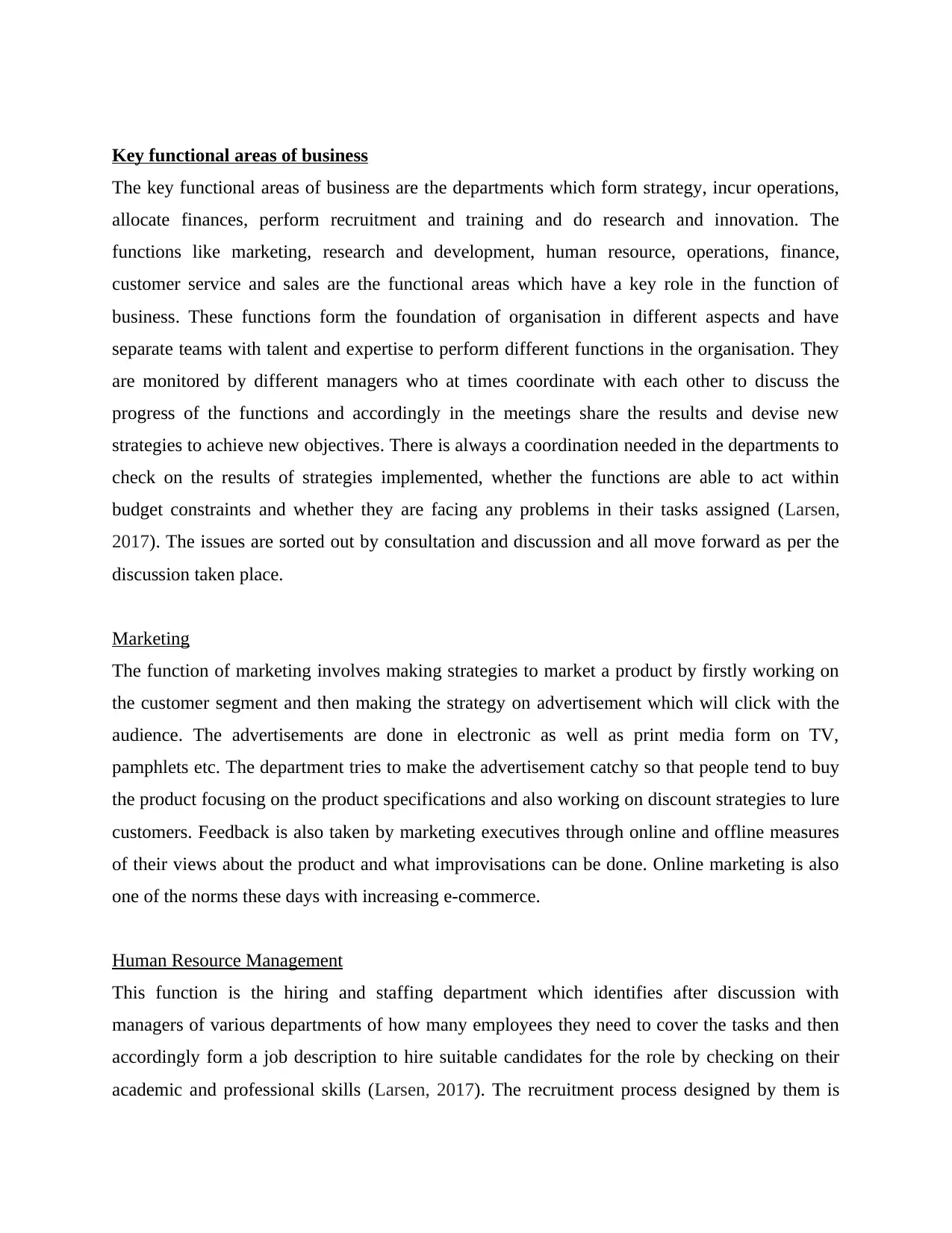
Key functional areas of business
The key functional areas of business are the departments which form strategy, incur operations,
allocate finances, perform recruitment and training and do research and innovation. The
functions like marketing, research and development, human resource, operations, finance,
customer service and sales are the functional areas which have a key role in the function of
business. These functions form the foundation of organisation in different aspects and have
separate teams with talent and expertise to perform different functions in the organisation. They
are monitored by different managers who at times coordinate with each other to discuss the
progress of the functions and accordingly in the meetings share the results and devise new
strategies to achieve new objectives. There is always a coordination needed in the departments to
check on the results of strategies implemented, whether the functions are able to act within
budget constraints and whether they are facing any problems in their tasks assigned (Larsen,
2017). The issues are sorted out by consultation and discussion and all move forward as per the
discussion taken place.
Marketing
The function of marketing involves making strategies to market a product by firstly working on
the customer segment and then making the strategy on advertisement which will click with the
audience. The advertisements are done in electronic as well as print media form on TV,
pamphlets etc. The department tries to make the advertisement catchy so that people tend to buy
the product focusing on the product specifications and also working on discount strategies to lure
customers. Feedback is also taken by marketing executives through online and offline measures
of their views about the product and what improvisations can be done. Online marketing is also
one of the norms these days with increasing e-commerce.
Human Resource Management
This function is the hiring and staffing department which identifies after discussion with
managers of various departments of how many employees they need to cover the tasks and then
accordingly form a job description to hire suitable candidates for the role by checking on their
academic and professional skills (Larsen, 2017). The recruitment process designed by them is
The key functional areas of business are the departments which form strategy, incur operations,
allocate finances, perform recruitment and training and do research and innovation. The
functions like marketing, research and development, human resource, operations, finance,
customer service and sales are the functional areas which have a key role in the function of
business. These functions form the foundation of organisation in different aspects and have
separate teams with talent and expertise to perform different functions in the organisation. They
are monitored by different managers who at times coordinate with each other to discuss the
progress of the functions and accordingly in the meetings share the results and devise new
strategies to achieve new objectives. There is always a coordination needed in the departments to
check on the results of strategies implemented, whether the functions are able to act within
budget constraints and whether they are facing any problems in their tasks assigned (Larsen,
2017). The issues are sorted out by consultation and discussion and all move forward as per the
discussion taken place.
Marketing
The function of marketing involves making strategies to market a product by firstly working on
the customer segment and then making the strategy on advertisement which will click with the
audience. The advertisements are done in electronic as well as print media form on TV,
pamphlets etc. The department tries to make the advertisement catchy so that people tend to buy
the product focusing on the product specifications and also working on discount strategies to lure
customers. Feedback is also taken by marketing executives through online and offline measures
of their views about the product and what improvisations can be done. Online marketing is also
one of the norms these days with increasing e-commerce.
Human Resource Management
This function is the hiring and staffing department which identifies after discussion with
managers of various departments of how many employees they need to cover the tasks and then
accordingly form a job description to hire suitable candidates for the role by checking on their
academic and professional skills (Larsen, 2017). The recruitment process designed by them is
Paraphrase This Document
Need a fresh take? Get an instant paraphrase of this document with our AI Paraphraser
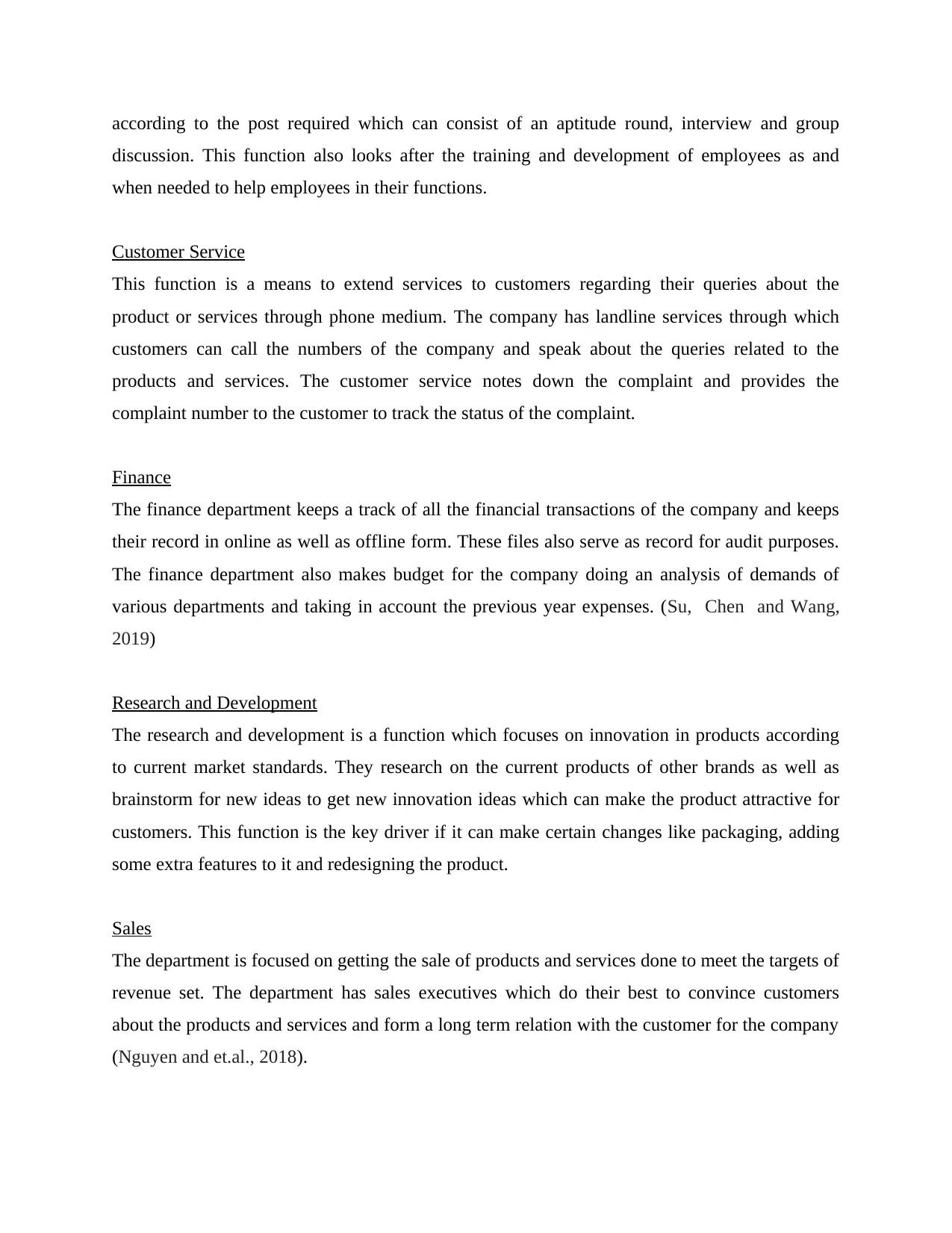
according to the post required which can consist of an aptitude round, interview and group
discussion. This function also looks after the training and development of employees as and
when needed to help employees in their functions.
Customer Service
This function is a means to extend services to customers regarding their queries about the
product or services through phone medium. The company has landline services through which
customers can call the numbers of the company and speak about the queries related to the
products and services. The customer service notes down the complaint and provides the
complaint number to the customer to track the status of the complaint.
Finance
The finance department keeps a track of all the financial transactions of the company and keeps
their record in online as well as offline form. These files also serve as record for audit purposes.
The finance department also makes budget for the company doing an analysis of demands of
various departments and taking in account the previous year expenses. (Su, Chen and Wang,
2019)
Research and Development
The research and development is a function which focuses on innovation in products according
to current market standards. They research on the current products of other brands as well as
brainstorm for new ideas to get new innovation ideas which can make the product attractive for
customers. This function is the key driver if it can make certain changes like packaging, adding
some extra features to it and redesigning the product.
Sales
The department is focused on getting the sale of products and services done to meet the targets of
revenue set. The department has sales executives which do their best to convince customers
about the products and services and form a long term relation with the customer for the company
(Nguyen and et.al., 2018).
discussion. This function also looks after the training and development of employees as and
when needed to help employees in their functions.
Customer Service
This function is a means to extend services to customers regarding their queries about the
product or services through phone medium. The company has landline services through which
customers can call the numbers of the company and speak about the queries related to the
products and services. The customer service notes down the complaint and provides the
complaint number to the customer to track the status of the complaint.
Finance
The finance department keeps a track of all the financial transactions of the company and keeps
their record in online as well as offline form. These files also serve as record for audit purposes.
The finance department also makes budget for the company doing an analysis of demands of
various departments and taking in account the previous year expenses. (Su, Chen and Wang,
2019)
Research and Development
The research and development is a function which focuses on innovation in products according
to current market standards. They research on the current products of other brands as well as
brainstorm for new ideas to get new innovation ideas which can make the product attractive for
customers. This function is the key driver if it can make certain changes like packaging, adding
some extra features to it and redesigning the product.
Sales
The department is focused on getting the sale of products and services done to meet the targets of
revenue set. The department has sales executives which do their best to convince customers
about the products and services and form a long term relation with the customer for the company
(Nguyen and et.al., 2018).
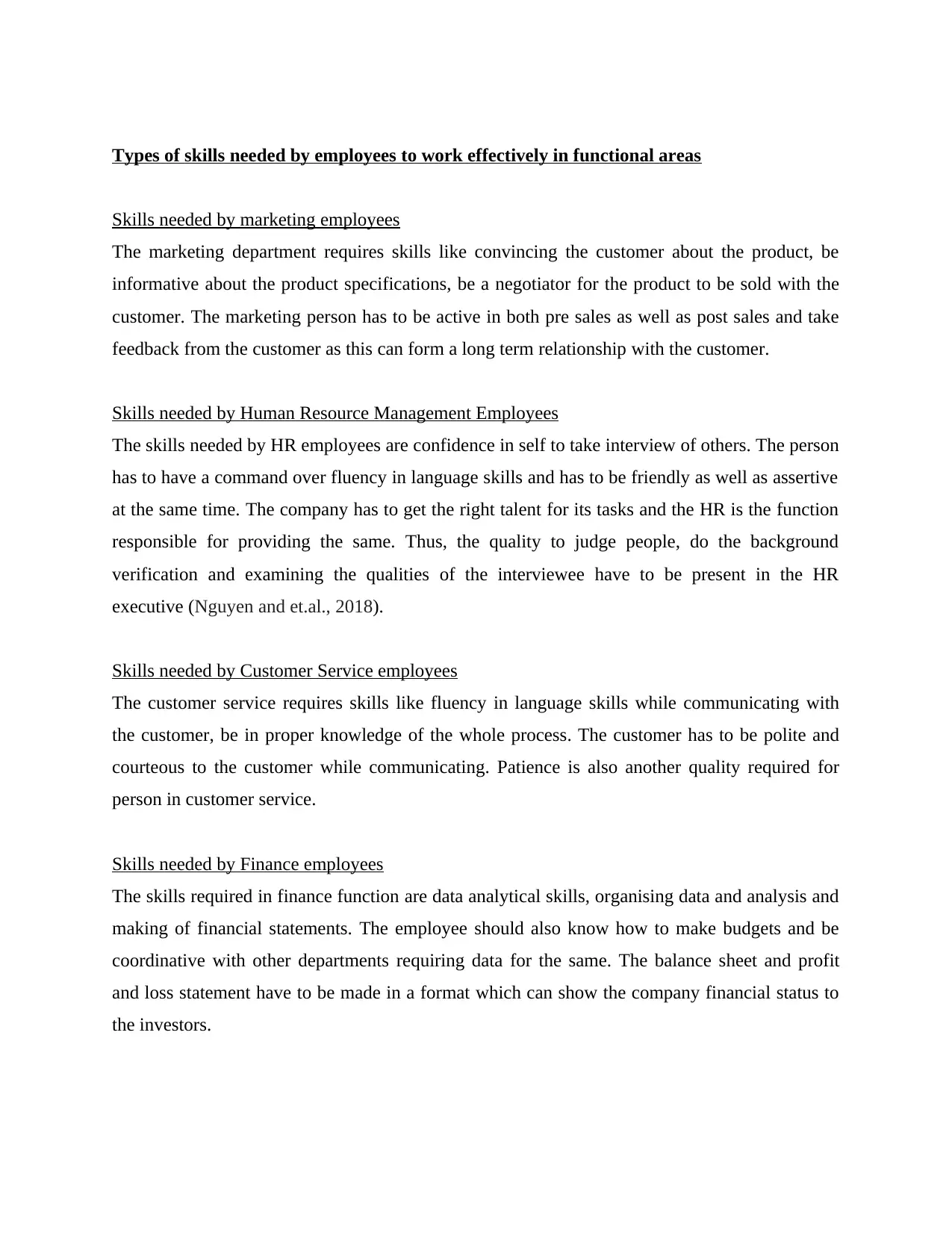
Types of skills needed by employees to work effectively in functional areas
Skills needed by marketing employees
The marketing department requires skills like convincing the customer about the product, be
informative about the product specifications, be a negotiator for the product to be sold with the
customer. The marketing person has to be active in both pre sales as well as post sales and take
feedback from the customer as this can form a long term relationship with the customer.
Skills needed by Human Resource Management Employees
The skills needed by HR employees are confidence in self to take interview of others. The person
has to have a command over fluency in language skills and has to be friendly as well as assertive
at the same time. The company has to get the right talent for its tasks and the HR is the function
responsible for providing the same. Thus, the quality to judge people, do the background
verification and examining the qualities of the interviewee have to be present in the HR
executive (Nguyen and et.al., 2018).
Skills needed by Customer Service employees
The customer service requires skills like fluency in language skills while communicating with
the customer, be in proper knowledge of the whole process. The customer has to be polite and
courteous to the customer while communicating. Patience is also another quality required for
person in customer service.
Skills needed by Finance employees
The skills required in finance function are data analytical skills, organising data and analysis and
making of financial statements. The employee should also know how to make budgets and be
coordinative with other departments requiring data for the same. The balance sheet and profit
and loss statement have to be made in a format which can show the company financial status to
the investors.
Skills needed by marketing employees
The marketing department requires skills like convincing the customer about the product, be
informative about the product specifications, be a negotiator for the product to be sold with the
customer. The marketing person has to be active in both pre sales as well as post sales and take
feedback from the customer as this can form a long term relationship with the customer.
Skills needed by Human Resource Management Employees
The skills needed by HR employees are confidence in self to take interview of others. The person
has to have a command over fluency in language skills and has to be friendly as well as assertive
at the same time. The company has to get the right talent for its tasks and the HR is the function
responsible for providing the same. Thus, the quality to judge people, do the background
verification and examining the qualities of the interviewee have to be present in the HR
executive (Nguyen and et.al., 2018).
Skills needed by Customer Service employees
The customer service requires skills like fluency in language skills while communicating with
the customer, be in proper knowledge of the whole process. The customer has to be polite and
courteous to the customer while communicating. Patience is also another quality required for
person in customer service.
Skills needed by Finance employees
The skills required in finance function are data analytical skills, organising data and analysis and
making of financial statements. The employee should also know how to make budgets and be
coordinative with other departments requiring data for the same. The balance sheet and profit
and loss statement have to be made in a format which can show the company financial status to
the investors.
⊘ This is a preview!⊘
Do you want full access?
Subscribe today to unlock all pages.

Trusted by 1+ million students worldwide
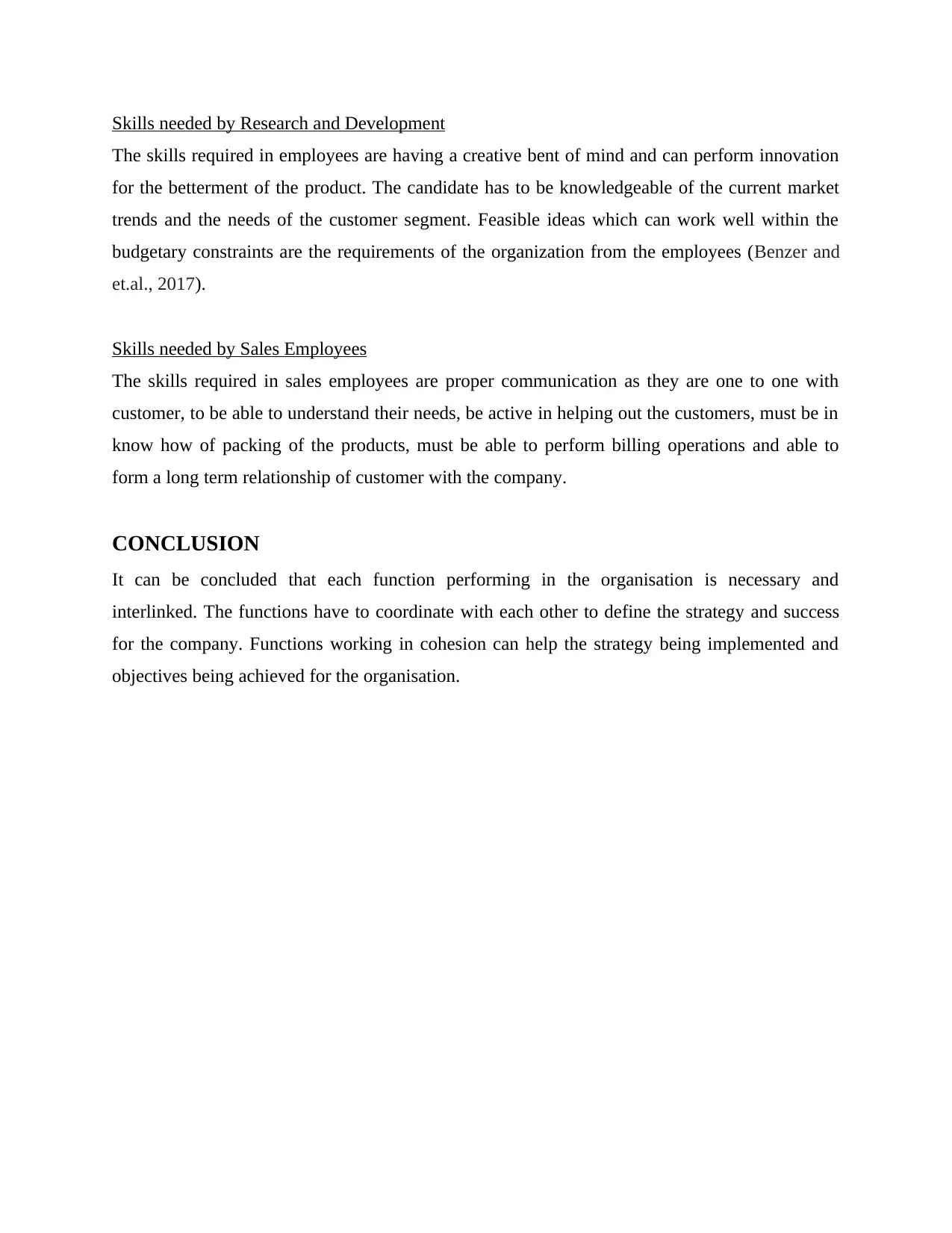
Skills needed by Research and Development
The skills required in employees are having a creative bent of mind and can perform innovation
for the betterment of the product. The candidate has to be knowledgeable of the current market
trends and the needs of the customer segment. Feasible ideas which can work well within the
budgetary constraints are the requirements of the organization from the employees (Benzer and
et.al., 2017).
Skills needed by Sales Employees
The skills required in sales employees are proper communication as they are one to one with
customer, to be able to understand their needs, be active in helping out the customers, must be in
know how of packing of the products, must be able to perform billing operations and able to
form a long term relationship of customer with the company.
CONCLUSION
It can be concluded that each function performing in the organisation is necessary and
interlinked. The functions have to coordinate with each other to define the strategy and success
for the company. Functions working in cohesion can help the strategy being implemented and
objectives being achieved for the organisation.
The skills required in employees are having a creative bent of mind and can perform innovation
for the betterment of the product. The candidate has to be knowledgeable of the current market
trends and the needs of the customer segment. Feasible ideas which can work well within the
budgetary constraints are the requirements of the organization from the employees (Benzer and
et.al., 2017).
Skills needed by Sales Employees
The skills required in sales employees are proper communication as they are one to one with
customer, to be able to understand their needs, be active in helping out the customers, must be in
know how of packing of the products, must be able to perform billing operations and able to
form a long term relationship of customer with the company.
CONCLUSION
It can be concluded that each function performing in the organisation is necessary and
interlinked. The functions have to coordinate with each other to define the strategy and success
for the company. Functions working in cohesion can help the strategy being implemented and
objectives being achieved for the organisation.
Paraphrase This Document
Need a fresh take? Get an instant paraphrase of this document with our AI Paraphraser
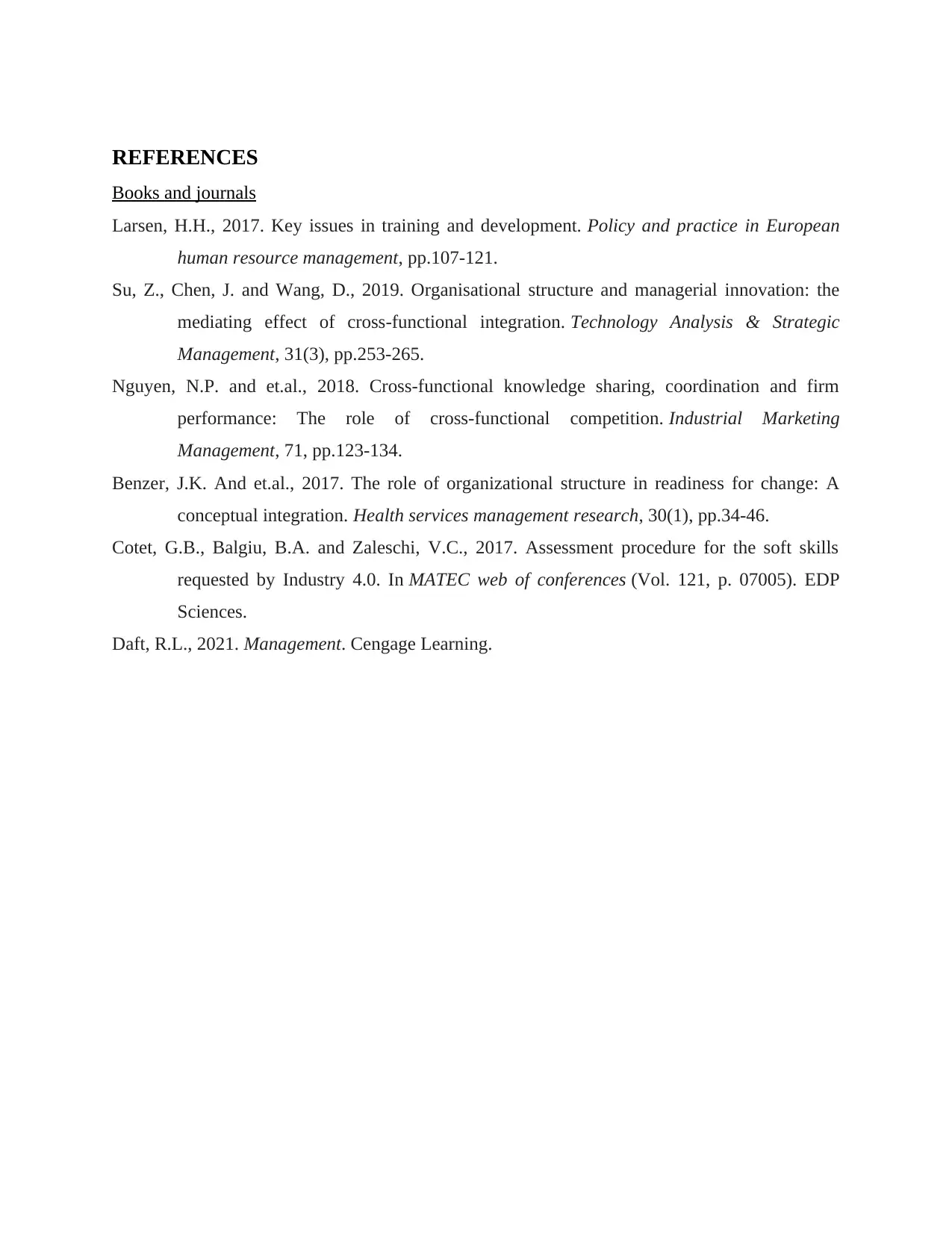
REFERENCES
Books and journals
Larsen, H.H., 2017. Key issues in training and development. Policy and practice in European
human resource management, pp.107-121.
Su, Z., Chen, J. and Wang, D., 2019. Organisational structure and managerial innovation: the
mediating effect of cross-functional integration. Technology Analysis & Strategic
Management, 31(3), pp.253-265.
Nguyen, N.P. and et.al., 2018. Cross-functional knowledge sharing, coordination and firm
performance: The role of cross-functional competition. Industrial Marketing
Management, 71, pp.123-134.
Benzer, J.K. And et.al., 2017. The role of organizational structure in readiness for change: A
conceptual integration. Health services management research, 30(1), pp.34-46.
Cotet, G.B., Balgiu, B.A. and Zaleschi, V.C., 2017. Assessment procedure for the soft skills
requested by Industry 4.0. In MATEC web of conferences (Vol. 121, p. 07005). EDP
Sciences.
Daft, R.L., 2021. Management. Cengage Learning.
Books and journals
Larsen, H.H., 2017. Key issues in training and development. Policy and practice in European
human resource management, pp.107-121.
Su, Z., Chen, J. and Wang, D., 2019. Organisational structure and managerial innovation: the
mediating effect of cross-functional integration. Technology Analysis & Strategic
Management, 31(3), pp.253-265.
Nguyen, N.P. and et.al., 2018. Cross-functional knowledge sharing, coordination and firm
performance: The role of cross-functional competition. Industrial Marketing
Management, 71, pp.123-134.
Benzer, J.K. And et.al., 2017. The role of organizational structure in readiness for change: A
conceptual integration. Health services management research, 30(1), pp.34-46.
Cotet, G.B., Balgiu, B.A. and Zaleschi, V.C., 2017. Assessment procedure for the soft skills
requested by Industry 4.0. In MATEC web of conferences (Vol. 121, p. 07005). EDP
Sciences.
Daft, R.L., 2021. Management. Cengage Learning.

⊘ This is a preview!⊘
Do you want full access?
Subscribe today to unlock all pages.

Trusted by 1+ million students worldwide
1 out of 9
Related Documents
Your All-in-One AI-Powered Toolkit for Academic Success.
+13062052269
info@desklib.com
Available 24*7 on WhatsApp / Email
![[object Object]](/_next/static/media/star-bottom.7253800d.svg)
Unlock your academic potential
Copyright © 2020–2025 A2Z Services. All Rights Reserved. Developed and managed by ZUCOL.





